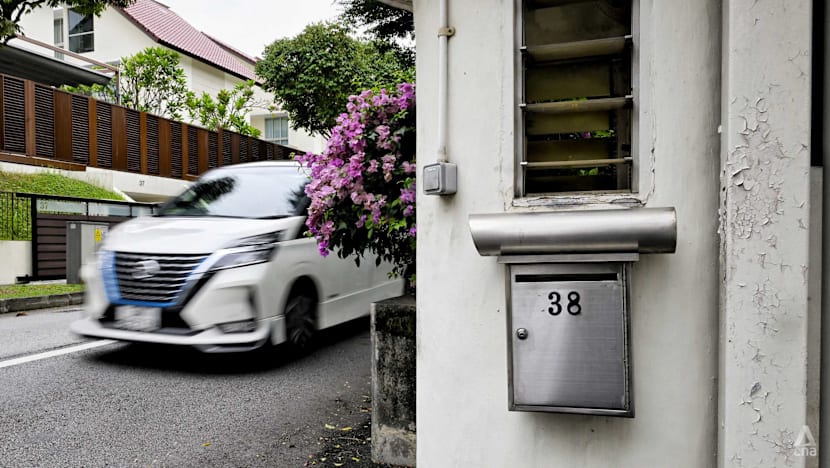Preserving 38 Oxley Road site not about memorialising any single leader: David Neo
The government reiterated it will respect the privacy wishes of Mr Lee Kuan Yew, and under no circumstances would the interior of the house be displayed, remodelled or duplicated.

A car passes by the guard post outside 38 Oxley Road, the estate of Singapore's first Prime Minister Lee Kuan Yew, on Nov 3, 2025. (Photo: CNA/Wallace Woon)

This audio is generated by an AI tool.
SINGAPORE: The preservation of the 38 Oxley Road site is not about memorialising any single leader but safeguarding Singapore's history for future generations, said Acting Minister for Culture, Community and Youth David Neo on Thursday (Nov 6).
Delivering a ministerial statement in parliament, Mr Neo emphasised the importance of preserving physical markers of Singapore's independence story.
“There will come a time when no one who has lived through Singapore’s struggle for independence will be around to recount these stories firsthand,” he said.
“But the sites and markers that we choose to keep today will continue to speak for them. They will remind us of our hard-fought path to becoming a multiracial, multireligious and sovereign nation.”
Earlier this week, the government announced its intention to gazette the 38 Oxley Road site – the family home of Singapore's founding Prime Minister Lee Kuan Yew – as a national monument.
A government advisory board assessed that the site was more than just a home, describing it as a place where Singapore's independence movement took shape.
“In preserving the site, we are not memorialising any single leader,” Mr Neo said. “We are safeguarding the grounds where future generations can stand – to understand where we came from, who we are and what we overcame together.”
INTERIOR OF HOUSE WILL NOT BE DUPLICATED
Mr Neo said the government's considerations for the move were “for the entire site, and not for the buildings or structures within it”.
Preserving the site “does not obligate the government to keep the buildings and structures within the site in their current condition”, he added, reiterating that the relevant authorities have not had the chance to enter the site to assess the conditions of the buildings and structures.
“That is a key reason why we are opting to preserve the site rather than just specific buildings or structures.”
If access to the site is obtained, the government will undertake a detailed study of the buildings and structures, taking into account factors like existing conditions and weighing the potential benefits of retaining them against the cost.
All options will be considered, including those outlined in a 2018 ministerial committee report, such as partial or full demolition of the buildings and structures, said the acting minister.

Mr Neo stressed that regardless of the option taken, the government will respect the wishes of Mr Lee and his wife, Mdm Kwa Geok Choo, and remove all traces of their private living spaces from the interior of the house.
Under no circumstances will the interior of the house as Mr Lee and Mdm Kwa knew, be displayed, recorded, remodelled or duplicated elsewhere, he added.
If the site is preserved and acquired, it will be converted into a public space, with one possible outcome being a heritage park, said the National Heritage Board and the Singapore Land Authority earlier.
This means the site cannot be redeveloped for residential, commercial or other private uses.
Mr Neo noted that many other countries have preserved and converted sites associated with their nation’s independence as spaces for public education and appreciation.
He cited the Gandhi Ashram in India and the Independence National Historical Park in the US. At these sites, changes were made, including modifying or adapting the original buildings with new interpretive structures to better enable the public to experience the site as a park or heritage space, said Mr Neo.
“That’s why we are keeping an open mind as to the treatment of the buildings and the structures within the site,” he told the House.
“We will keep all options open, and strive for a solution that will unite us as a country, rather than allow this to become a point of contention or division in our society.”
Long-running saga
The announcement marks the latest development in a saga that has unfolded since Mr Lee's death on Mar 23, 2015.
The property was his home from 1950 until his death, and where his three children – Senior Minister Lee Hsien Loong, the late Dr Lee Wei Ling and Mr Lee Hsien Yang – grew up.
Mr Lee Kuan Yew had on several occasions publicly expressed his wish for the house to be demolished after his death. In an October 2010 letter to the Cabinet, he stated it should “not be kept as a kind of relic for people to tramp through” and that it has “no merit as architecture”.
He reiterated his stance in a July 2011 letter to the Cabinet, but faced opposition from ministers.
In December 2011, Mr Lee wrote that he had reflected on the matter after the Cabinet unanimously opposed demolition, and decided that if the property were to be preserved, it should have its foundations reinforced and be refurbished and let out for people to live in, as an empty building would “soon decline and decay”.
Yet in his final will executed in 2013, Mr Lee returned to saying he wanted the house demolished, or if that were not possible, closed to everyone except family and descendants.
The fate of the house would become the source of dispute among his children following his death, leading then-Prime Minister Lee Hsien Loong to make a ministerial statement in 2017.
A ministerial committee on 38 Oxley Road was also convened, chaired by then Deputy Prime Minister and Coordinating Minister for National Security Teo Chee Hean. It released a final report in April 2018 with three proposals - retaining the house in whole; retaining just the historic basement dining room; or allowing demolition.
The report made no recommendations and noted "there (was) no need to make a decision on the property" at the time, as Dr Lee Wei Ling was still living there.
After Dr Lee’s passing in October last year, the Urban Redevelopment Authority received a demolition application for the building at 38 Oxley Road. This application was made by Mr Lee Hsien Yang.
In the same month, the National Heritage Board launched a formal assessment of the site to determine if it is worthy of preservation.
In its assessment released this week, the Preservation of Sites and Monuments Advisory Board assessed the site as having "strong national significance worthy of preservation as a national monument", describing it as a foundational part of Singapore's independence that is "not represented by any other site or monument".
Mr Lee Hsien Yang has slammed the announcement. In a Facebook post on Nov 3, he wrote that the ruling government had “chosen to trample on Lee Kuan Yew’s unwavering wish to demolish his private house”.
WHAT’S NEXT
Mr Neo said the government “fully intends to conclude its plans on the exact use and configuration of the site ... well within this term of government”, if the site is preserved and acquired.
The current government was sworn in on May 23 this year, with a term of up to five years.
In the interim, there will be no public access to 38 Oxley Road, he told the House.
The authorities said on Monday that the site's owner – 38 Oxley Road Pte Ltd – has been given written notice of the intention to make a preservation order and has until Nov 17 to submit any objections to the authorities.
A check of Accounting and Corporate Regulatory Authority records shows that Mr Lee Hsien Yang is the sole shareholder of the company, while his son Li Huanwu is registered as the director.
Mr Neo noted that the National Heritage Board will submit to him any objections received, alongside their recommendations.
“All objections submitted and recommendations made will be considered objectively and fairly as part of due process,” he added.
If the government decides to proceed with the preservation, a preservation order will be made and it will commence the process for the acquisition of the site.
Such an acquisition will be done in accordance with established processes, with compensation being made in accordance with the Land Acquisition Act, the acting minister said.
The owner, any occupiers and any other persons interested will be given the opportunity to submit their claims to the Singapore Land Authority to determine the compensation.
A professional private valuer would also be appointed to assist the Singapore Land Authority in determining the market value of the land, taking into consideration any claims submitted.
If the owner or any person interested is not satisfied with the compensation awarded, an appeal can be filed with the Land Acquisition Appeals Board.
“MOST RESPONSIBLE” APPROACH
Mr Neo said the government has arrived at this approach because it is the “most responsible” one.
He pointed to the report issued by a ministerial committee convened in 2018 on the matter, noting that the committee had said a future government would have to make an informed and considered decision on the matter when it becomes necessary.
“This is the future government and the time is now,” said Mr Neo.
“We will take the deliberate steps to decide and we will do so in the best interest of Singapore and Singaporeans, now and for the future.”

















